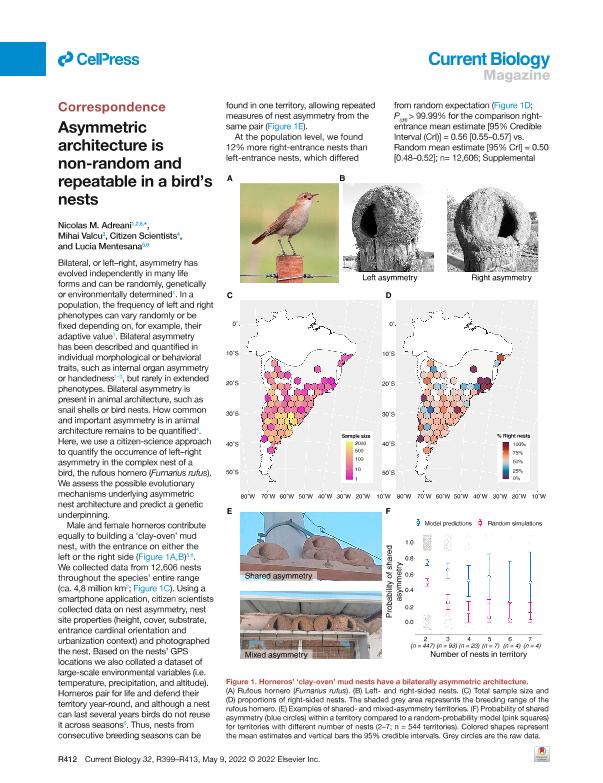Artículo
Asymmetric architecture is non-random and repeatable in a bird's nests
Citizen Scientists; Adreani, Mauricio Nicolas; Valcu, Mihai; Mentesana, Lucia; Sorroche, Silvina Andrea; Martina, Daniela Veronica; Bender, Benjamin

Fecha de publicación:
05/2022
Editorial:
Cell Press
Revista:
Current Biology
ISSN:
0960-9822
Idioma:
Inglés
Tipo de recurso:
Artículo publicado
Clasificación temática:
Resumen
Bilateral, or left–right, asymmetry has evolved independently in many life forms and can be randomly, genetically or environmentally determined1. In a population, the frequency of left and right phenotypes can vary randomly or be fixed depending on, for example, their adaptive value1. Bilateral asymmetry has been described and quantified in individual morphological or behavioral traits, such as internal organ asymmetry or handedness1–3, but rarely in extended phenotypes. Bilateral asymmetry is present in animal architecture, such as snail shells or bird nests. How common and important asymmetry is in animal architecture remains to be quantified4. Here, we use a citizen-science approach to quantify the occurrence of left–right asymmetry in the complex nest of a bird, the rufous hornero (Furnarius rufus). We assess the possible evolutionary mechanisms underlying asymmetric nest architecture and predict a genetic underpinning.
Palabras clave:
Extended phenotype
,
Nest
,
Citizen science
Archivos asociados
Licencia
Identificadores
Colecciones
Articulos(IADIZA)
Articulos de INST. ARG DE INVEST. DE LAS ZONAS ARIDAS
Articulos de INST. ARG DE INVEST. DE LAS ZONAS ARIDAS
Citación
Citizen Scientists; Adreani, Mauricio Nicolas; Valcu, Mihai; Mentesana, Lucia; Sorroche, Silvina Andrea; et al.; Asymmetric architecture is non-random and repeatable in a bird's nests; Cell Press; Current Biology; 32; 9; 5-2022; R412-R413
Compartir
Altmétricas



